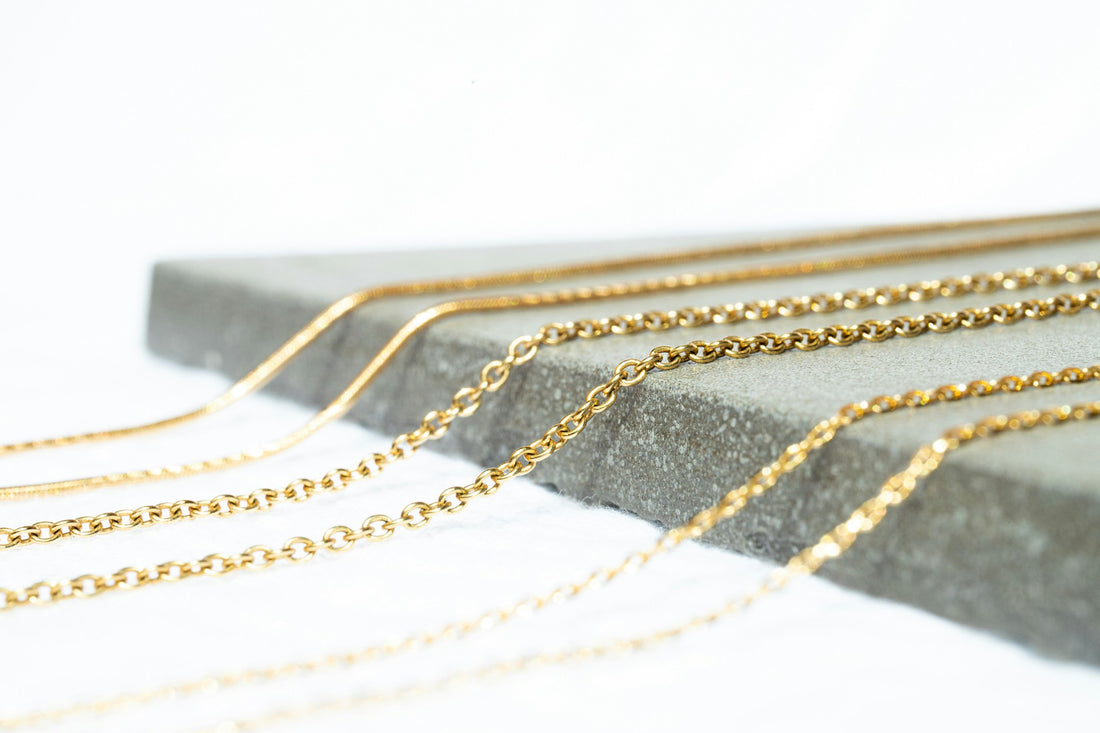When buying gold, you might encounter terms like 24k, 18k, 14k, or 9k. These refer to the carat (k) system, which indicates the purity of gold in a given piece. Understanding the differences between these carats is essential, as it affects not just the value but also the durability and appearance of the gold. In this blog post, we'll break down the differences between gold carats to help you make an informed decision.
What is a Carat?
A carat (k) in gold refers to the purity level of the metal.
Pure gold is 24 carats, meaning that all 24 parts in the gold are pure gold without any other metals mixed in.
However, pure gold is relatively soft, making it unsuitable for most jewelry that needs to withstand daily wear. To improve its strength and durability, gold is often mixed with other metals like silver, copper, or zinc, resulting in different carat levels. Here's a breakdown of the most common carat ratings:

24 Carat Gold (24k)
- Purity: 99.9% pure gold
- Characteristics: 24k gold is the purest form of gold available. It has a distinct bright yellow color and is highly malleable, making it very soft and easily bendable.
- Pros: Because of its purity, 24k gold is hypoallergenic and won't tarnish over time. It is also the most valuable form of gold.
- Cons: The softness of 24k gold means it is not ideal for everyday wear, as it can easily get scratched or deformed. It's commonly used for gold bars, coins, and occasionally for pieces of jewelry that are not meant for frequent use.
- Usage: Mainly used in investment gold like coins and bars, sometimes used in high-end jewelry.
18 Carat Gold (18k)
- Purity: 75% pure gold, mixed with 25% other metals (silver and copper)
- Characteristics: 18k gold has a rich yellow color, but it's slightly less vibrant than 24k gold. The added metals improve its strength and durability while retaining much of the gold's natural beauty.
- Pros: 18k gold is much harder than 24k gold, making it more suitable for everyday jewelry like rings, bracelets, and necklaces. It strikes a good balance between purity, color, and durability.
- Cons: It is still relatively soft compared to lower carat golds, so it can get scratched if not cared for properly.
- Usage: Popular in fine jewelry such as engagement rings, earrings, and other pieces that are worn regularly.
14 Carat Gold (14k)
- Purity: 58.3% pure gold, mixed with 41.7% other metals
- Characteristics: 14k gold has a more muted yellow color than 18k and 24k gold, with a slightly more pronounced presence of the alloy metals. It is considerably stronger than both 24k and 18k gold.
- Pros: Due to its durability and affordability, 14k gold is one of the most popular choices for everyday jewelry. It offers a good balance between appearance, cost, and strength.
- Cons: Since it has a higher proportion of alloy metals, 14k gold may cause skin irritation for those sensitive to certain metals.
- Usage: Commonly used in a wide range of jewelry, including wedding bands, bracelets, and pendants.
9 Carat Gold (9k)
- Purity: 37.5% pure gold, mixed with 62.5% other metals
- Characteristics: 9k gold has a noticeably lighter yellow hue compared to higher carat golds, and the alloy metals dominate its composition. It is the hardest and most durable of the commonly used gold carats (however is weak in the chains)
- Pros: 9k gold is the most affordable type of gold used in jewelry. Its durability makes it suitable for jewelry that will be worn daily and subjected to rougher wear and tear.
- Cons: Its lower gold content means it lacks the rich color of higher carat golds.
- Usage: Often used in more affordable jewelry pieces, including rings, chains, and earrings.
Comparing the Carats: Which One Should You Choose?
- Durability: If you’re looking for something that can withstand daily wear and tear, 14k or 9k gold might be the best option. They are less likely to scratch or bend compared to higher carat golds.
- Color and Aesthetics: If you desire a piece with a rich, vibrant yellow color, 18k gold offers a beautiful balance of color and durability.
- Budget: 24k gold is the most expensive due to its purity, followed by 18k, 14k, and 9k. If you’re on a budget but still want a gold piece, 9k or 14k gold provides a more affordable option.
- Allergies: People with sensitive skin may prefer 18k or 24k gold, as they contain fewer alloy metals that can cause allergic reactions.

Final Thoughts
Understanding the differences between gold carats can help you make an informed choice based on your preferences, lifestyle, and budget. Whether you're investing in gold for its value or looking for the perfect piece of jewelry to complement your style, knowing what each carat level offers will guide you toward the best decision.
In summary, 24k gold is the purest but softest form, while 9k gold offers maximum durability at a lower cost. 18k and 14k golds are popular middle-ground choices, balancing purity, durability, and price. Choose the carat that aligns with your priorities, whether it's investment, everyday wear, or a special occasion.

